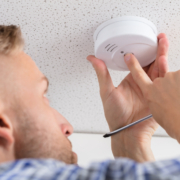What you need to know about your homes smoke detectors.
It may be a surprise to many of you that smoke detectors or automatic smoke alarms have been around since before 1900. They were first invented in England by a guy named George Andrew Darby. Around the same time, the U.S. National Fire Protection Agency was established, and it’s that government agency that regulates all things fire protection and prevention to this day.
Nowadays, everyone has smoke detectors in their home, and most of us don’t pay attention to them until they start annoyingly chirping in the middle of the night. There are currently two types available to consumers, Ones that use photoelectric sensors and ones that utilize ionization sensors. They both accomplish the same goal of warning occupants of a possible fire condition, but they have various attributes. The ionization typw works better at detecting a flaming fire and the photoelectric type work better at sensing a smoldering fire. For best results, a homeowner should have a mix of the two types of smoke detectors in their home or, for optimal effectiveness, a dual-sensor-type.
The NFPA code recommends installing smoke detectors in every bedroom, outside each bedroom, and at least one on every home floor. If a building level doesn’t have a bedroom, installing a smoke detector in the main living area is preferred. As we all know, heat and smoke rises, so homeowners should install smoke detectors within a foot of the ceiling. It’s a great idea for the highest margin of safety to have all hard-wired smoke detectors on the same branch circuit; that way, if one detector goes off, they all will go off.
No doubt you’ve been awakened at night by a chirping smoke detector; that’s the alarm’s way of telling you that the backup battery is running low and needs to be replaced. An easy way to remember to charge the battery is to change all your smoke detector batteries when the time changes. When you’re up there replacing the batteries, please take a quick look at the sensing ports to make sure they aren’t clogged with dust, as that will inhibit the sensors’ ability to function correctly. Also, it would be best if you never paint your smoke detector for the same reason.
Like everything in this world, smoke detectors have a lifespan, and they are designed to function for about ten years and then be replaced. If your smoke detectors are yellow, then it’s well past their expected lifespan. They aren’t yellow because of a previous owner’s smoking habits but rather because of a fire retardant chemical called bromine that is in the plastic; bromine causes the plastic to turn yellow with age. Yellow smoke detectors may be working fine at the moment, but it would be prudent to replace them.




Leave a Reply
Want to join the discussion?Feel free to contribute!